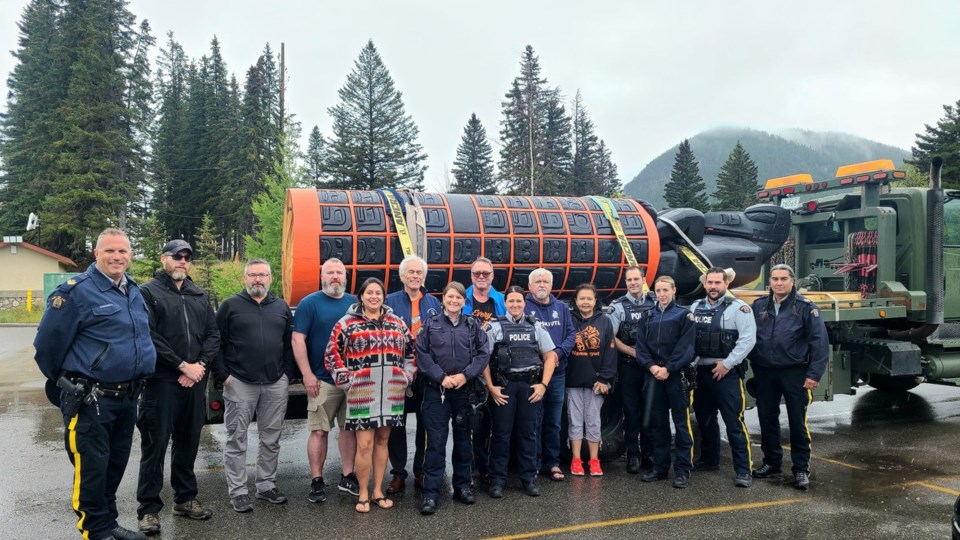The seven-tonne monument was escorted through Banff Sept. 7 by local RCMP on the back of a Canadian Armed Forces vehicle and is on its way to the Canadian Museum of History in Gatineau, Quebec, where it will become a centrepiece intended to uplift and honour the spirits of the many Indigenous children abused by the residential school system.
“I wanted this to tell the truth of what happened and not shade the truth,” said Hunt of the carving. “I really, really felt that the children needed a monument. How do we know what those kids would have ever become? They might have become RCMP officers, they might have served in wars, they might have been in the Navy, they might have been teachers and lawyers and doctors.
“But they weren’t given the chance to live a life. I find that incredibly sad for those children, that they didn’t get to live a life.”
It took the artist 11 months to complete the monument in his backyard in Fort Rupert on Vancouver Island, with the help of his nephew and apprentice Rey Dickie, internationally acclaimed carver Merv Child, and with funding from Hunt’s friend and Vancouver businessman, Ray Bergen.
Carved by hand into the red cedar log, believed to be about 700 years old, are about 130 faces, each of them unique and expressing different levels of grief and painted in black to represent a “dark time in history.”
Above them a raven is perched.
“The reason is, in our [Kwagiulth] culture, the raven is considered our Creator,” Hunt explained. “If you look closely at the raven’s beak, he’s got a little seed – it’s called the seed of life.
“This raven is put on top of these children to help us find them, to help us identify them and to give them a proper memorial.”
The Truth and Reconciliation Commission’s final report, which documented the experiences of 6,000 witnesses, most of whom survived the experience of living in residential schools as students, estimates at least 4,100 children died or went missing while attending the institutions.
Hunt, who is from Kwakiutl First Nation on the northeastern shores of Vancouver Island, near Port Hardy, said both his parents, his sister and many aunts and uncles were forced to attend residential school.
The federal government funded the institutions, which were run by the church. According to the federal government, about 150,000 people are believed to have gone through the residential school system. The last of Canada’s 139 schools closed in 1998.
Hunt said travelling with the monument across the country from Fort Rupert, B.C. has been an “incredible” experience.
“We’ve had people come up and speak to us that just literally had tears flowing down their face, just to see it. It sparks so much emotion out of so many different people,” he said. “For the response that people get from it, it’s almost the same every time – they just want to come over and they want to touch it, feel it, and [as] soon as they make contact with it, they break down.
“To me, if you show emotion like that, it means that you’re healing. So, I hope that it’s helping people deal with their past.”
Support from various groups, such as the RCMP, which have been escorting the monument and its party across jurisdictional lines, has not gone unnoticed, Hunt added.
Banff RCMP were on-hand the morning of Sept. 7 when the carving crossed the B.C. and Alberta border and escorted it safely through.
Staff Sgt. Mike Buxton-Carr said the detachment was honoured to answer the call to assist when it heard the monument was on its way.
He acknowledged the history between the North-West Mounted Police, which would eventually become RCMP, and Indigenous peoples. On the monument, an inverted cross is carved. Inside the cross, other symbols representing the NWMP, RCMP and Canada are also inverted.
“For the Banff RCMP, it’s important that we listen and understand what reconciliation may mean to the Indigenous Nations that call this area home or that frequent this area, or with whom we interact,” said Buxton-Carr.
“We have a connection with Indigenous persons and with residential schools to some degree that is not always something that we look back on with pride. In many ways, this was an opportunity for us to reflect on the troubling relationship that our organization has had with Indigenous peoples.
“Hopefully, by participating and supporting things such as a sacred monument, we can show that we’re listening or recognizing the challenges in the relationship, as well as the opportunities for healthy relationships.”




